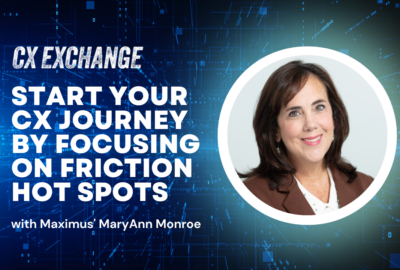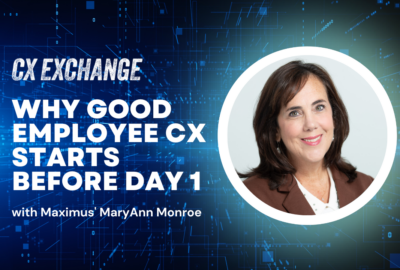Insight by Maximus
CX Exchange 2024: Maximus’ MaryAnn Monroe on the only experience metric that matters
Agencies should combine data from customers and employees to drive total experience improvements, Maximus’ TX leader advises.
The true measure of federal customer experience efforts isn’t how much money a program office spends or the technology it implements.
No, the only metric that truly matters is citizen satisfaction.
For example at one office in the Veterans Affairs Department, that means increasing the number of medical disability examinations the program office can perform.
“We’ve done a lot of work and continue to work to modernize that whole process, including the back end to automate where it makes sense and to make the process go more smoothly and swiftly — and ultimately improve that overall experience,” said MaryAnn Monroe, vice president, total experience solutions and services at Maximus, during the Federal News Network’s 2024 CX Exchange. “We’re able to work with VA in terms of turning around those reports and those forms in a timely manner.”
Monroe said Maximus has worked with VA to more than double the number of examinations that the program office can complete. She credited the modernization of the disability examination process, while still maintaining high satisfaction levels with the services.
Examples similar to VA’s are becoming more common across all agencies as they mature their customer experience initiatives. Agencies are using an assortment of tools and techniques to drive the basic and advanced concept of total experience, which combines both customer experience and employee experience.
“We are seeing cost reduction savings as one key measure and burden reduction as another measure of return on investment that many agencies are really zeroing in on,” Monroe said. “The programs we support — where we are modernizing and digitizing forms to make it easier, faster, more effective to apply online for benefits and services — a really important metric that more agencies are paying attention to is how to decrease the burden that customers have in their everyday life interacting with a government service.”
Human-centered design and total experience
Another important piece to improving the total experience of a program is listening to the voice of the customer.
Monroe said all agencies, at the very least, should be investing in their ability to collect data from their customers about their experiences.
“The data that you get from that really helps to elevate understanding of areas you can zero in on and improve. Then weaving in other human-centered design and qualitative strategies into how you do your work every day is a great way to layer in other ways of capturing data where you’re actually talking to the people you’re serving,” she said.
“There are several agencies that are investing in their platforms to collect voice of employee as well. We collect that information in our unified desktop where our employees are working and touching millions of citizens every day through our programs. We’re able to capture their sentiment, as well as their feedback.”
But it’s not just collecting the customer feedback. Agencies must do more to understand what their customers are telling them. Monroe said that means agencies need to take structured and unstructured data into account.
“Those open comments or those texts sentiment and voice sentiment gives them signals or insights into possible pain points and problems or highlights good things that they want to highlight and dig into deeper,” she said. “Voice of customer is a great place to start. But I would say you need to marry that with other data to really get a better picture, and also with your qualitative research that you should be doing or have contractual support to do as well.”
Agencies can build these voice of the customer or employee programs by starting with the basics outlined by Office of Management and Budget Circular A-11.
Employee data increasingly important to experience design
Monroe said the guidance provides a “nice, simple structure” to build customer experience programs.
Agencies also shouldn’t overlook the importance of collecting data from their own employees as well, she added. She said one agency Maximus works with is overlaying Federal Employee Viewpoint Survey with customer satisfaction data to help drive changes.
“In some of our programs, we are pulling in a lot of the operational metrics that come from web analytics and contact center analytics, with experience analytics, both from the customer reaching out, but also from the employee. So having that viewpoint of operational and experiential is critically important,” Monroe said.
“It’s critically important that the agencies and programs that have the right skill set of those data analysts that are really focusing on understanding the data, understanding what it’s telling us and being able to sift through to prioritize what might be the most important places to go first to fix or to problem solve. It’s really filtering it down to the customer data and the employee data and trying to use that to prioritize very specifically an action plan.”
Discover more customer experience tactics and takeaways from Federal News Network’s CX Exchange 2024 now.
Copyright © 2025 Federal News Network. All rights reserved. This website is not intended for users located within the European Economic Area.
Jason Miller is executive editor of Federal News Network and directs news coverage on the people, policy and programs of the federal government.
Follow @jmillerWFED






